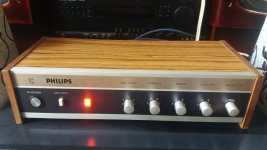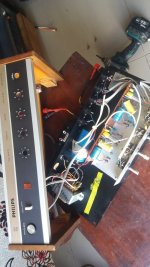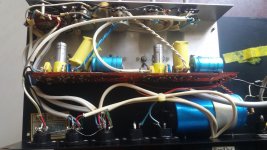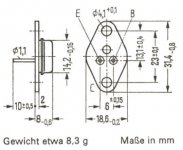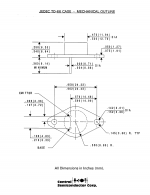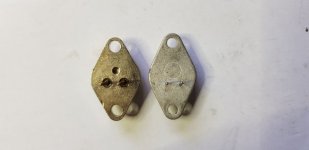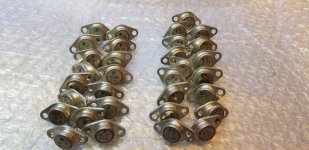I have a Philips amplifier, but I searched on Google for nothing about this line, I don't know what model it was. The following fee information is blurred.
Everyone who can help me, thank you!
Everyone who can help me, thank you!
Attachments
I go back on what I said. Can you turn the amp over. The output BJTs are mounted underneath. Will be interesting to see what they are. Not terribly powerul going on the transformer size. There are probably covers over them that may come off easily - unclipped from inside the case.
Kevin
Kevin
Last edited:
Those outputs look like TO-66’s. The lead spacing looks too tight to be TO-3. Did they ever make a Ge device in TO-66? Or are they To-3s and my eyes are deceiving me?
I think this is the one 23RH581 Ampl/Mixer Philips Australia, build 1972, 1 pictures
Mona
yes, thank you very much
Though looking very similar, AD161/162 aren't TO-66. This case is/was called SOT-9.
Best regards!
Best regards!
I've always considered AD161/162 as TO66 cases. From the time in the seventies when I ruined the home stereo of my parents. The wooden cabinet with the circuit drawing glued inside with all the details. SOT is smd or am I wrong?
No offence Kay (you do post substantial contributions here I admire), but I'm quiet sure here!
No offence Kay (you do post substantial contributions here I admire), but I'm quiet sure here!
So am I 🙂
These are/were TO-66, and the AD-149 was TO-3 🙂
Edit: Actually... Kay is right too. Same, but different names acoording to different standards
OUTLINES • Abmessungen und Diagramme
These are/were TO-66, and the AD-149 was TO-3 🙂
Edit: Actually... Kay is right too. Same, but different names acoording to different standards
OUTLINES • Abmessungen und Diagramme
Attachments
Last edited:
SOT-9 isn't TO-66. The document above shows TO-66 in brackets, which most probably has to be interpreted as similar, but not the same as SOT-9. Please have a close look at the attached drwaings and my photo of actual devices (left SOT-9, right TO-66). They differ that much that you can't swap mica insulators. Pin pitch is smaller in TO-66, while the mounting holes' distance is smaller in SOT-9, just to name the most obvious.
Best regards!
Best regards!
Attachments
Not worth mentioning, MarsBravo 😉!
In my youth we did many smallish amplifiers with these AD161/162's, extracting merely 4 watts from them @ 12 Vdc/4 ohms and 10 % THD 😱. They were predominantly copies of car radio AF amplifiers, without emitter resistors and with some elaborated resistor/NTC networks for thermal stability.
There are still some leftovers from that time 😉.
Me, too, was baffled when I first encountered 2N3054's as TO-66 devices. Astonishingly similar, but using the same micas failed thoroughly.
Best regards!
In my youth we did many smallish amplifiers with these AD161/162's, extracting merely 4 watts from them @ 12 Vdc/4 ohms and 10 % THD 😱. They were predominantly copies of car radio AF amplifiers, without emitter resistors and with some elaborated resistor/NTC networks for thermal stability.
There are still some leftovers from that time 😉.
Me, too, was baffled when I first encountered 2N3054's as TO-66 devices. Astonishingly similar, but using the same micas failed thoroughly.
Best regards!
Attachments
...failed... That's a trigger of a very remote memory (first half eighties): I had to do some mechanical 'rework' to get things together. All was TO66 with such casings, or not manufactured according to specifications. Lost track of that annoying experience, but now it has cleared things up finaly!Astonishingly similar, but using the same micas failed thoroughly.
- Home
- Amplifiers
- Solid State
- What is this Philips amplifier?
